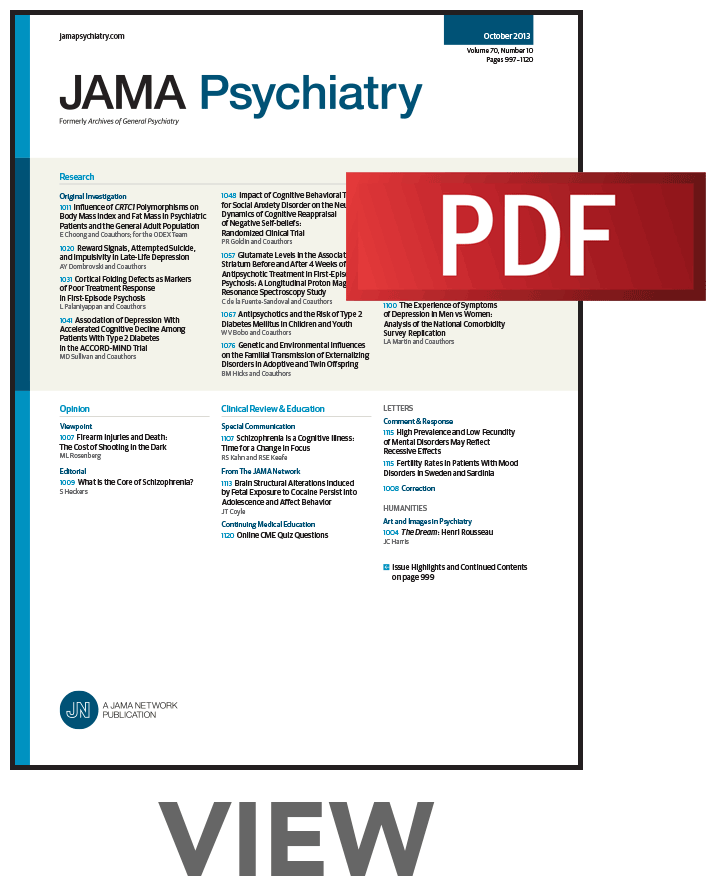创伤后应激障碍诊断丧失对循证治疗的反应:一项系统回顾和荟萃分析。
IF 17.1
1区 医学
Q1 PSYCHIATRY
引用次数: 0
摘要
近几十年来,以证据为基础的治疗创伤后应激障碍(PTSD)的心理疗法已经发展起来。然而,在临床试验中观察到的疗效并不总是直接适用于临床实践。目的估计军人和退伍军人(以下简称退伍军人)和非退伍军人在治疗后失去PTSD诊断的比例。数据来源我们使用创伤后应激障碍知识库来识别基于有效评估的DSM-IV/DSM-5 PTSD诊断的成人研究。该资料库由美国国家创伤后应激障碍研究中心维护,不断更新随机临床试验,包括1988年1月以来发表的研究。研究选择为了获得资格,PTSD必须是主要治疗目标,心理治疗作为单一治疗。符合条件的研究报告了治疗后不符合PTSD诊断标准的参与者数量。当审查开始时(2023年10月),存储库包含496个独特的研究。数据分析于2023年10月至2024年6月完成。数据提取和综合数据库遵循系统评价和荟萃分析首选报告项目(PRISMA)报告指南,并使用Cochrane Risk of Bias 2.0。我们使用混合效应逻辑回归模型来估计诊断损失,并将身体状况和性别作为协变量。主要结果和测量主要结果是经验证的仪器评估的治疗后不再符合PTSD诊断标准的参与者的比例。结果纳入34项随机临床试验(N = 3208名受试者)。对于非milvet样本,创伤集中治疗的诊断损失点估计从65%到86%不等。与非Milvet样本相比,Milvet样本在认知加工治疗和长时间暴露的研究中诊断损失的比例较低,从44%到50%不等。milvet状态和性别的协变量之间存在大量重叠。一项探索性分析发现,眼动脱敏和再加工是诊断损失比例最高的,但存在很大的异质性,而且没有一项研究以milvet为重点,也没有在美国进行。此外,95%置信区间部分重叠的所有创伤为重点的治疗估计。结论和相关性本系统综述和荟萃分析通过荟萃分析每种心理治疗的诊断损失概率,为PTSD的心理治疗提供了大量文献。在开始治疗或讨论治疗进展的潜在障碍时,诊断损失数据是讨论潜在益处的相对直接的方法。本文章由计算机程序翻译,如有差异,请以英文原文为准。
Loss of PTSD Diagnosis in Response to Evidence-Based Treatments: A Systematic Review and Meta-Analysis.
Importance
In recent decades, evidence-based psychotherapies to treat posttraumatic stress disorder (PTSD) have been developed with robust evidence bases. However, efficacy observed in clinical trials is not always directly applicable to clinical practice.
Objective
To estimate the percentage of patients in both military and veteran (hereafter milvet) and nonmilvet populations that lose their PTSD diagnosis after treatment.
Data Sources
We used the PTSD Repository to identify studies with adults with a DSM-IV/DSM-5 PTSD diagnosis based on a validated assessment. The repository, maintained by the US National Center for PTSD, is continually updated with randomized clinical trials and includes studies published from January 1988 on.
Study Selection
For eligibility, PTSD had to be the primary treatment target, with psychotherapy applied as monotreatment. Eligible studies reported the number of participants who did not meet diagnostic criteria for PTSD posttreatment. When this review was initiated (October 2023), the repository contained 496 unique studies. Data analysis was completed from October 2023 to June 2024.
Data Extraction and Synthesis
The repository follows Preferred Reporting Items for Systematic Reviews and Meta-analyses (PRISMA) reporting guidelines and uses Cochrane Risk of Bias 2.0. We used mixed-effects logistic regression models to estimate diagnosis loss and incorporated milvet status and sex as covariates.
Main Outcomes and Measures
The primary outcome was the proportion of participants who no longer met criteria for a diagnosis of PTSD posttreatment as assessed by a validated instrument.
Results
We included 34 randomized clinical trials (N = 3208 participants). Point estimates of diagnosis loss across trauma-focused treatments for nonmilvet samples ranged from 65% to 86%. Milvet samples had lower proportions of diagnosis loss in studies of cognitive processing therapy and prolonged exposure compared to nonmilvet samples, ranging from 44% to 50%. There was substantial overlap between the covariates of milvet status and sex. An exploratory analysis identified eye movement desensitization and reprocessing as having the highest proportion of diagnosis loss, but there was substantial heterogeneity, and none of the studies were milvet-focused or conducted in the US. Also, 95% confidence intervals partially overlapped for all trauma-focused treatment estimates.
Conclusions and Relevance
This systematic review and meta-analysis contributes to the substantial literature on psychotherapeutic treatments for PTSD by meta-analyzing the probabilities of diagnosis loss for each psychotherapy. Diagnosis loss data are a relatively straightforward way to discuss potential benefits when initiating a therapy or when discussing potential barriers to progress in treatment.
求助全文
通过发布文献求助,成功后即可免费获取论文全文。
去求助
来源期刊

JAMA Psychiatry
PSYCHIATRY-
CiteScore
30.60
自引率
1.90%
发文量
233
期刊介绍:
JAMA Psychiatry is a global, peer-reviewed journal catering to clinicians, scholars, and research scientists in psychiatry, mental health, behavioral science, and related fields. The Archives of Neurology & Psychiatry originated in 1919, splitting into two journals in 1959: Archives of Neurology and Archives of General Psychiatry. In 2013, these evolved into JAMA Neurology and JAMA Psychiatry, respectively. JAMA Psychiatry is affiliated with the JAMA Network, a group of peer-reviewed medical and specialty publications.
 求助内容:
求助内容: 应助结果提醒方式:
应助结果提醒方式:


